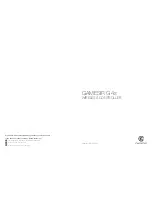
Pixie
7
strings on the controller must use the same RGB IC.
Generally, 5vdc strings are usually limited to 50
pixels because of voltage drop due to the current
draw. 12vdc pixel strings are good for 100 pixels.
Low power 12v pixels are good to 150 per string.
Important Considerations
When powered by 5vdc, the Pixie controllers cannot
supply the voltage (9vdc) required by most LOR
accessories.
LOR effects (fading, twinkling, shimmer) done by the
controller require a lot of memory. The Pixie16D can
perform these effects on the first 50 pixels of each
string, the Pixie8D on 100, and the Pixie2D and
Pixie4D on 200. If you are running the network in
Enhanced mode, these effects will be done by the
Show Director or PC, so the memory limitation does
not apply and LOR effects are available on 200 pixel
strings for all controllers.
We recommend leaving the top-most jumper off
when configuring the RJ45 network jack wiring for
LOR network mode. This disables accessory power
to the network jacks. There have been problems
with incorrectly user-made cables which swap wires
and short out the accessory power supplies. This
becomes a problem with multiple controllers as
significant current may be available.
First vs. Second Generation Boards
First generation Pixies do not have Unit ID DIP
switches and do not have reverse power protection
circuitry. Reverse power protection only protects the
controller; it does not protect the pixel strings.
Pixie
8
For WS2811 (800KHz) and WS2801 pixels, the
output networks on the pixel ports of first generation
boards allow up to 40’ between the controller and
the first pixel. This is increased to 80’ for second
generation boards. You may need to run heavier
wire (18 gauge) to prevent voltage drop on the
power leads to the first pixel, especially for 5v pixels.
Voltage drop usually manifests itself as pixels
appearing pink when white at full power is chosen.
Network Protocols and Speeds
There are three network protocols currently in use:
LOR Normal, LOR Enhanced, & PixieLink.
LOR normal is the protocol that has been used by
LOR controllers from year 0. It is the only way to
access the CCR/CCB/CCP compatibility mode
resolution, color effects and macros channels.
LOR Enhanced protocol is a newer compressed
data protocol designed specifically for high density
pixel displays. It pretty much is required for even a
moderately active display.
PixieLink protocol is used between a PixieLink
E1/31/Art-Net Adapter and Pixies. The PixieLink
Adapter allows Pixies and other LOR G3 controllers
to be used over Ethernet.
The Pixie controllers understand all protocols and
automatically detect network speeds from 19.2Kbits
per second up to 8.5Mbit per second(Mbps). All
delivered Pixies have at least 5Mbps comm chips,
and will always work with PixieLink at 4.25Mbps.
They will usually work with PixieLink at 8.5Mbps.
The 8-pin socketed chip near the RJ45 jack may




































